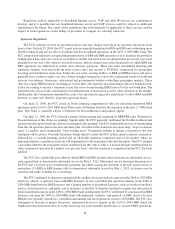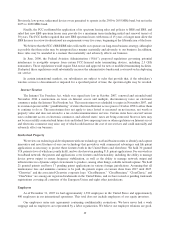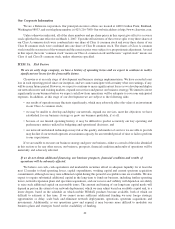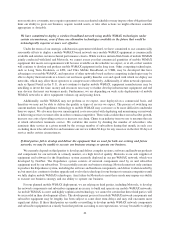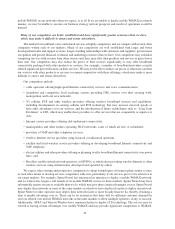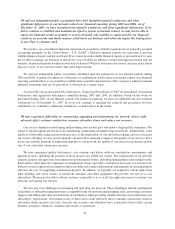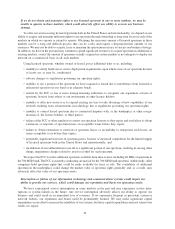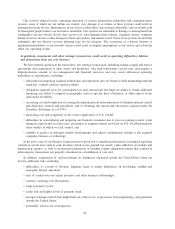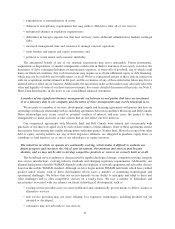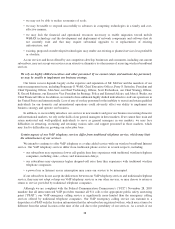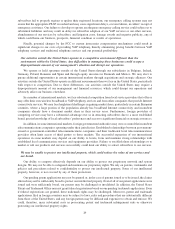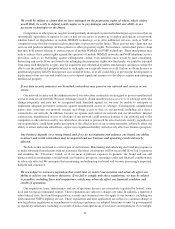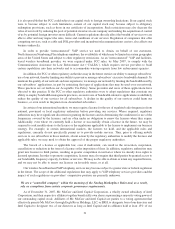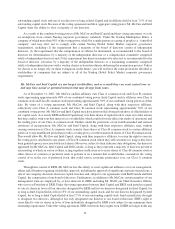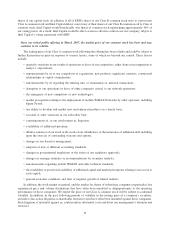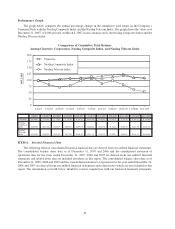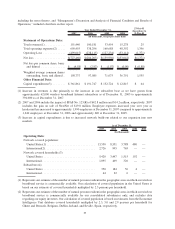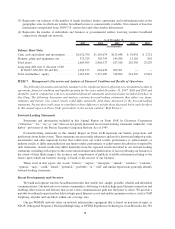Clearwire 2007 Annual Report Download - page 36
Download and view the complete annual report
Please find page 36 of the 2007 Clearwire annual report below. You can navigate through the pages in the report by either clicking on the pages listed below, or by using the keyword search tool below to find specific information within the annual report.• we may not be able to realize economies of scale;
• we may be unable to respond successfully to advances in competing technologies in a timely and cost-
effective manner;
• we may lack the financial and operational resources necessary to enable migration toward mobile
WiMAX technology and the development and deployment of network components and software that do
not currently exist and that may require substantial upgrades to or replacements of existing
infrastructure; and
• existing, proposed or undeveloped technologies may render our existing or planned services less profitable
or obsolete.
As our services and those offered by our competitors develop, businesses and consumers, including our current
subscribers, may not accept our services as an attractive alternative to other means of receiving wireless broadband
services.
We rely on highly skilled executives and other personnel. If we cannot retain and motivate key personnel,
we may be unable to implement our business strategy.
Our future success depends largely on the expertise and reputation of Mr. McCaw and the members of our
senior management team, including Benjamin G. Wolff, Chief Executive Officer, Perry S. Satterlee, President and
Chief Operating Officer, John Saw, our Chief Technology Officer, Scott Richardson, our Chief Strategy Officer,
R. Gerard Salemme, our Executive Vice President for Strategy, Policy and External Affairs, and John A. Butler, our
Chief Financial Officer. In addition, we intend to hire additional highly skilled individuals to staff our operations in
the United States and internationally. Loss of any of our key personnel or the inability to recruit and retain qualified
individuals for our domestic and international operations could adversely affect our ability to implement our
business strategy and operate our business.
In addition, to successfully introduce our services in new markets and grow our business in existing domestic
and international markets, we rely on the skills of our general managers in these markets. If we cannot hire, train and
retain motivated and well-qualified individuals to serve as general managers in our markets, we may face
difficulties in attracting, recruiting and retaining various sales and support personnel in those markets, which
may lead to difficulties in growing our subscriber base.
Certain aspects of our VoIP telephony services differ from traditional telephone service, which may limit
the attractiveness of our services.
We intend to continue to offer VoIP telephony as a value added service with our wireless broadband Internet
service. Our VoIP telephony services differ from traditional phone service in several respects, including:
• our subscribers may experience lower call quality than they experience with traditional wireline telephone
companies, including static, echoes and transmission delays;
• our subscribers may experience higher dropped-call rates than they experience with traditional wireline
telephone companies;
• a power loss or Internet access interruption may cause our service to be interrupted.
If our subscribers do not accept the differences between our VoIP telephony services and traditional telephone
service, they may not adopt or keep our VoIP telephony services or our other services, or may choose to retain or
return to service provided by traditional telephone companies.
Although we are compliant with the Federal Communication Commission’s (“FCC”) November 28, 2005
mandate that all interconnected VoIP providers transmit all 911 calls to the appropriate public safety answering
point (“PSAP”), our VoIP emergency calling service is significantly more limited than the emergency calling
services offered by traditional telephone companies. Our VoIP emergency calling service can transmit to a
dispatcher at a PSAP only the location information that the subscriber has registered with us, which may at times be
different from the actual location at the time of the call due to the portability of our services. As a result, if our
28


